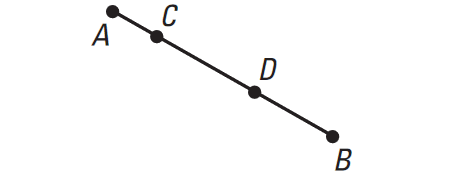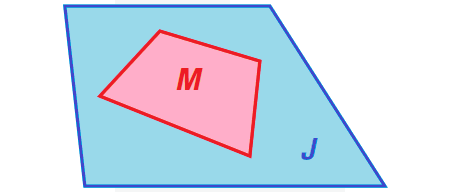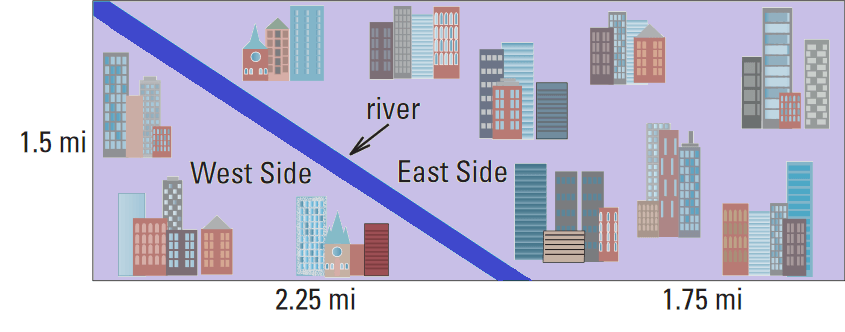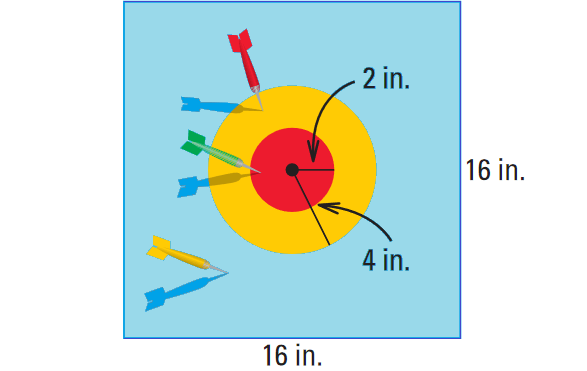GEOMETRIC PROBABILITY
Subscribe to our ▶️ YouTube channel 🔴 for the latest videos, updates, and tips.
Probability :
A probability is a number from 0 to 1 that represents the chance that an event will occur. Assuming that all outcomes are equally likely, an event with a probability of 0 cannot occur. An event with a probability of 1 is certain to occur,and an event with a probability of 0.5 is just as likely to occur as not.
We already know, how to evaluate probabilities by counting the number of favorable outcomes and dividing that number by the total number of possible outcomes.
In this section, we will use a related process in which the division involves geometric measures such as length or area. This process is called geometric probability.
Geometric Probability
Probability and Length :
In the diagram shown below, AB is a segment that contains the segment CD.

If a point K on AB is chosen at random, then the probability that it is on CD is as follows :

Probability and Area :
In the diagram shown below, J is a region that contains region M.

If a point K in J is chosen at random, then the probability that it is in region M is as follows :

Finding a Geometric Probability
Example 1 :
Find the probability that a point chosen at random on RS is on TU.

Solution :

P(Point is on TU) = 2/10
P(Point is on TU) = 1/5
So, the probability can be written as 1/5 or 0.2 or 20%.
Example 2 :
Mr. Johnson works for a temporary employment agency. He lives on the west side of town and prefer to work there. The work assignments are spread evenly throughout the rectangular region shown below. Find the probability that an assignment chosen at random for Mr. Johnson is on the west side of town.

Solution :
The west side of town is approximately triangular.
Its area is
= 1/2 ⋅ 2.25 ⋅ 1.5
= 1.69 square miles
The area of the rectangular region is
= 1.5 • 4
= 6 square miles
So, the probability that the assignment is on the west side of town is

P(Assignment is on west side) ≈ 1.69/6
P(Assignment is on west side) ≈ 0.28
So, the probability that the work assignment is on the west side is about 28%.
Using Areas to Find a Geometric Probability
Example 3 :
A dart is tossed and hits the dart board shown below. The dart is equally likely to land on any point on the dart board. Find the probability that the dart lands in the red region.

Solution :
Find the ratio of the area of the red region to the area of the dart board.

P(Dart lands in red region) = π(2)2/162
P(Dart lands in red region) = 4π/256
Use calculator.
P(Dart lands in red region) ≈ 0.05
So, the probability that the dart lands in the red region is about 0.05, or 5%.
Using a Segment to Find a Geometric Probability
Example 4 :
Mr. Jacob is visiting San Francisco and taking a trolley ride to a store on Market Street. He is supposed to meet a friend at the store at 3:00 P.M. The trolleys run every 10 minutes and the trip to the store is 8 minutes. Mr. Jacob arrives at the trolley stop at 2:48 P.M. What is the probability that Mr. Jacob will arrive at the store by 3:00 P.M.?
Solution :
To begin, find the greatest amount of time Mr. Jacob can afford to wait for the trolley and still get to the store by 3:00 P.M. Because the ride takes 8 minutes, he needs to catch the trolley no later than 8 minutes before 3:00 P.M., or in other words by 2:52 P.M. So, Mr. Jacob can afford to wait 4 minutes (2:52 º 2:48 = 4 min). He can use a line segment to model the probability that the trolley will come within 4 minutes.

The required probability is

P(Get to store by 3:00) = 4/10
P(Get to store by 3:00) = 2/5
So, the probability that Mr. Jacob will arrive at the store by 3:00 P.M. is 2/5 or 0.4 or 40%.
Subscribe to our ▶️ YouTube channel 🔴 for the latest videos, updates, and tips.
Kindly mail your feedback to v4formath@gmail.com
We always appreciate your feedback.
©All rights reserved. onlinemath4all.com
Recent Articles
-
SAT Math Practice
Dec 05, 25 04:04 AM
SAT Math Practice - Different Topics - Concept - Formulas - Example problems with step by step explanation -
10 Hard SAT Math Questions (Part - 37)
Dec 03, 25 07:02 AM
10 Hard SAT Math Questions (Part - 37) -
Factorial Problems and Solutions
Dec 02, 25 09:27 AM
Factorial Problems and Solutions

